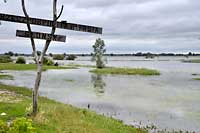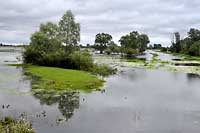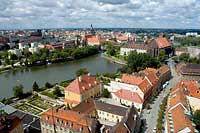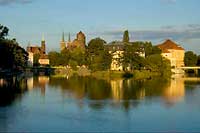BETWEEN THE ODRA AND WARTA RIVERS
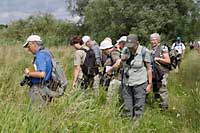
This wooded area, sandwiched between two big rivers, contains numerous lakes, ponds and wet grasslands criss-crossed by cuts and tributaries to create perfect habitats for birdlife. The two largest ornithological reserves in Poland, Slonsk and Milickie Ponds, are visited at the start and finish of this 300 kilometre tour.
ITINERARY
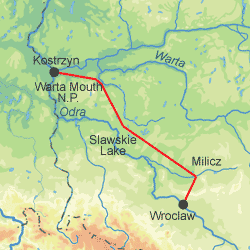
DAY ONE
Arrive in Berlin, transferring directly by train or coach to Kostrzyn, just across the border. Kostrzyn lies at the confluence of the Warta and Odra rivers. If you arrive early, there will be an afternoon walk through riverside meadows. Overnight at Kostrzyn.
DAY TWO
Full day visit to one of Poland’s largest bird reserves - Slonsk [4244 ha, Ramsar Site]. It supports about 130 species of birds, over 100 of which nest there, including: Little grebe Tachybaptus ruficollis, Great Crested Grebe Podiceps cristatus, Black-necked Grebe P. nigricollis, Cormorant Phalacrocorax carbo, Bittern Botaurus stellaris, Little Bittern Ixobrychus minutus, Shoveler Anas clypeata, Pochard Aythya ferina, Tufted Duck A. fuligula, White-winged Black Tern Chlidonias leucopterus, Little Tern Sterna albifrons, Oystercatcher Haematopus ostralegus, Redshank Tringa totanus Common Snipe Gallinago gallinago, Ruff Philomachus pugnax, and Marsh Harrier Circus aeruginosus. It is also a place where many species of bird moult, winter or halt during spring and autumn passage. Sometimes, 100000 geese can be seen here. In the evening transfer to Miedzyrzecz for an overnight stay.
DAY THREE
We start with a visit to the area of Nietoperek nature reserve, where enormous old bunkers have become refuges for colonies of bats, before moving on to Pszczewski Landscape Park [18774 ha] which protects old deciduous forests, interspresed with 20 scattered lakes connected by small rivers. 208 species of birds have been recorded in the Park, 140 of them breeding, for instance: Cormorant Phalacrocorax carbo, Bittern Botaurus stellaris, Little Bittern Ixobrychus minutus, Grey Heron Ardea cinerea, Greylag Goose Anser anser, Goldeneye Bucephala clangula, Honey Buzzard Pernis apivorus, Black Kite Milvus migrans and Marsh Harrier Circus aeruginosus. In the evening we transfer to Slawa for an overnight stay.
DAY FOUR
The day begins at dawn with a birdwatching trip to the forest and to Slawskie Lake. Birds which nest here include: Cormorant Phalacrocorax carbo, Bittern Botaurus stellaris, Little Bittern Ixobrychus minutus, Grey Heron Ardea cinerea, Black Stork Ciconia nigra, Mute Swan Cygnus olor, Tufted Duck Aythya fuligula, Goldeneye Bucephala clangula, Black Kite Milvus migrans, Red Kite M. milvus, Crane Grus grus, Common Snipe Gallinago gallinago and Penduline Tit Remiz pendulinus.
DAY FIVE
Transfer to Milicz. On the way we will stop to visit two important bird areas, before noon the vast 15000 hectare complex of water meadows along the Odra river and its canals. There are many nesting birds, including: Black Stork Ciconia nigra, White Stork C. ciconia, Greylag Goose Anser anser, Hobby Falco subbuteo, Lesser Spotted Eagle Aquila pomarina, Corncrake Crex crex, Black-tailed Godwit Limosa limosa, Curlew Numenius arquata, River Warbler Locustella fluviatilis and Great Grey Shrike Lanius excubitor. In the afternoon we pause at Woniesc reservoir where 130 species of birds nest: Red-necked Grebe Podiceps griseigena, Black-necked Grebe P. nigricollis, Greylag Goose Anser anser, Gadwall Anas strepera, Shoveler A. clypeata, Spotted Crake Porzana porzana, Little Ringed Plover Charadrius dubius, Redshank Tringa totanus, Black Tern Chlidonias niger, Penduline Tit Remiz pendulinus, and Common Rosefinch Carpodacus erythrinus. During autumn passage over 10000 birds, mainly plovers Charadriiformes, stay here. Overnight stay in the vicinity of Milicz.
DAY SIX
Full day trip to the western part of the Milickie Ponds complex. Milickie fish-ponds were created along the River Barycz . The whole complex is 35 kilometres long and partly protected as a nature reserve totalling 5324 hectares - the largest ornithological reserve in Poland. About 150 species of birds nest in the Barycz valley. This area is also an important refuge for migratory birds. In the western part of the complex we can find nesting birds such as: Cormorant Phalacrocorax carbo, Bittern Botaurus stellaris, Little Bittern Ixobrychus minutus, Black Stork Ciconia nigra, White Stork C. ciconia, Marsh Harrier Circus aeruginosus, Black Kite Milvus migrans, White-tailed Eagle Haliaetus albicilla, Little Crake Porzana parva, Crane Grus grus, Black Tern Chlidonias niger, and Kingfisher Alcedo atthis. Overnight at the same place.
DAY SEVEN
Full day trip to the eastern part of the Milickie Ponds complex and the water meadows of the Barycz river. Nesting birds include: Greylag Goose Anser anser, Ferruginous Duck Aythya nyroca, Bearded Tit Panurus biarmicus, Black Tern Chlidonias niger, White-tailed Eagle Haliaetus albicilla, Marsh Harrier Circus aeruginosus, Corncrake Crex crex, Lapwing Vanellus vanellus, Common Snipe Gallinago gallinago, Curlew Numenius arquata, and Redshank Tringa totanus. In the afternoon we transfer to Wroclaw [optionally Warsaw] for an overnight stay.
DAY EIGHT
Before departing for home, we have the chance to visit the old city of Wroclaw, full of historical monuments.
OPTIONAL VISITS
During this tour optional visits can be arranged to the following important historical monuments.- Miedzyrzecz - remains of the gothic castle and church founded in the 14th century
- Miedzyrzecz Fortified Front - an enormous complex of bunkers connected by tunnels, built by Germany in the 1930s
- Goscikowo - Cistercian abbey founded in 1230
- Koscian - gothic church from the 14th century with priceless furnishings
- Lubin - Benedictine abbey established in 1075
- Racot - classical palace surrounded by a beautiful park
- Pawlowice - one of the most valuable classical palaces, designed by Langhans
- Rydzyna - small town with a well-preserved baroque [!] urban scheme and numerous architectural monuments
- Wroclaw - a 1000 year-old city, the capital of Lower Silesia, 652000 inhabitants. The city is full of historic monuments, and amongst the most famous are: the market square with gothic city hall [14/15th c.], St. John's Cathedral [13-15th c.], Holiest Virgin Mary church [14th c.], and the baroque university buildings with Aula Leopoldina









